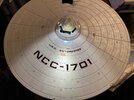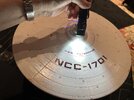Karl Tate here, I'm a fan consultant to TOMY on the project.
The wide engraved gridlines are a function of the diecast metal process. They are as thin as the factory could make them. To get thinner the whole model would have had to have been made of plastic. This is a licensed "die cast" model that can have a certain percentage of plastic construction but not that much.
Areas on the model where you see finer detail and thinner lines are plastic parts.
As it is the engraved lines are about twice the thickness they "should" be, to be in-scale.
The TOMY hangar bay stops short with a conceptual wall or door at the forward end (the yellow area in the Probert drawing). The landing bay and cargo area seen in TMP take up most of the volume of the secondary hull and was just not possible to do for this product.
View attachment 1943223
The matte paintings of the cargo/hangar area in the film shows retracted door panels between the shuttle lift and the cargo staging area. For TOMY's model we added a conceptual second door between the shuttle lift and the landing floor.
View attachment 1943228
The prototype shown at Star Trek Las Vegas last August also had this forward landing bay door. I think this is a reasonable extrapolation if not strictly accurate.
View attachment 1943229


